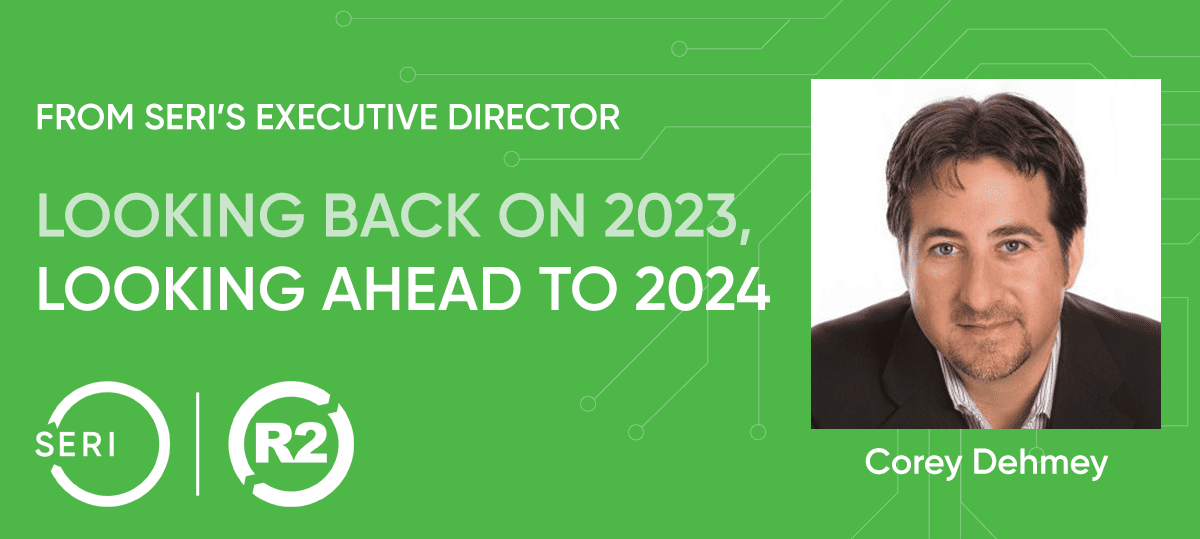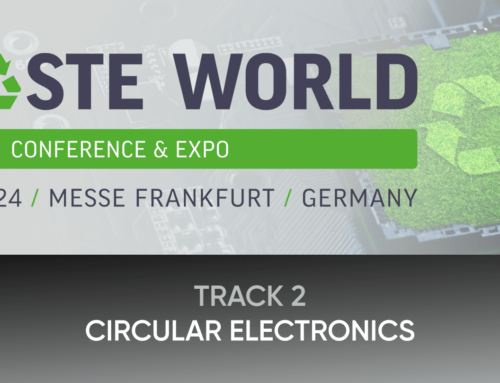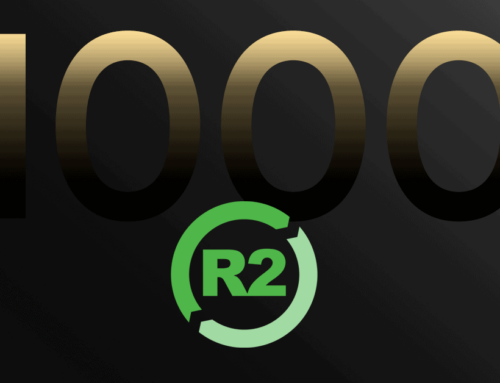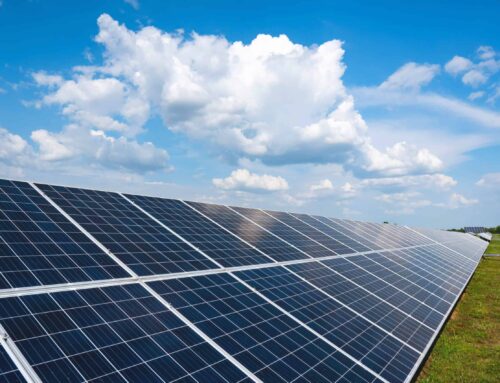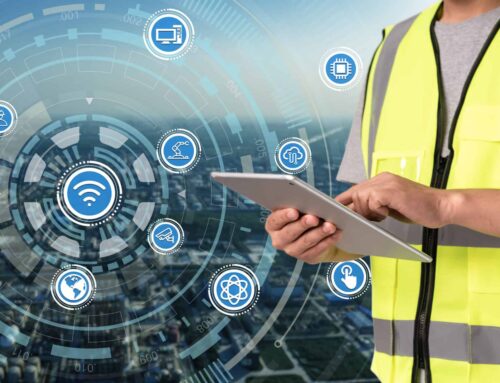At this time of year, I like to reflect on the past 12 months, thinking about our learnings and our accomplishments. One of my biggest takeaways is that our team at SERI is extremely ambitious and deeply passionate about our mission of achieving electronics sustainability. This is evident in all the hard work and energy we poured into a wide range of programs, projects, and conferences throughout 2023. And while we accomplished a lot, we are far from done. In fact, going into the new year we are expanding the team, welcoming new ambitious members to do even more. I am grateful for our small but mighty group that works hard to maximize our resources to create the biggest impact possible, and I am looking forward to seeing what we can accomplish as a larger group in 2024.
Speaking of accomplishments, for SERI, the biggest success of 2023 was finishing the transition from R2:2013 to R2v3 in June. As R2 continues to be widely adopted in 41 countries around the world, we saw growth exceed the 1,000 certified facilities mark and now stands at 1,100. R2 continues to be how customers know their data is protected, that electronics are reused to further digital inclusion, and at the end of life, that they are responsibly recycled in an environmentally sound manner. Global demand for sustainable electronics reuse and recycling facilities continues to grow, and SERI added new accreditation bodies in India and Australia in 2023 in response. While the R2 Certification program remains strong, additional programs are needed for SERI to fulfill its mission, and we are excited for what new initiatives like R2U, ReThink, the Champions Program, and an ESG Reporting Standard will bring in 2024. SERI continues to grow, but it’s knowing where we’ve come from that helps us keep perspective on where we need to head next. This is especially true because as the world tackles the e-waste challenge, we recognize we are all at different points in the journey, and much can be learned from past experiences.
A look back on the evolution of the industry
In 2008, the United States Environmental Protection Agency (EPA) released the Responsible Recycling Practices, a standard developed by stakeholders including recyclers, OEMs, and government. It’s hard to believe that it has been 15 years of R2, but it is remarkable to think how far we have progressed. In 2007, I started my own journey in electronics sustainability. I was an IT professional tasked with figuring out what to do with warehouses filled with old IT equipment from the U.S. Navy. I had to learn about data sanitization, ITAD, and recycling. And, yes, simply from a lack of knowledge, I made some of the bad choices that I advocate against others doing today. It has been a long road, but I have witnessed such an improvement in knowledge and capabilities that has led to more sustainable outcomes. Yet we aren’t nearly close to a world where we can have all the life improvement benefits of electronics without irreparable damage to the future for our children. We still need to do more as a society, and we can have both our tech toys and sustainability together with better decisions throughout.
After 15 years, I can look back and see the evolution of the R2 Standard. In the first version, R2 reflected a need to stop rampant pollution of the world with more responsible environmental practices. The problem at that time was people unscrupulously posing as recyclers, who only filled a container and dumped it in a foreign country halfway around the world. The R2 Standard largely succeeded in recognizing legitimate recyclers and differentiating them from those imposters. But that was only the beginning, because even as R2:2008 was released, a vibrant Microsoft refurbisher community was gaining traction. You see, technology in the desktop and laptop world had matured by this time, so when businesses refreshed their IT equipment after fully depreciating it in 3 years, there was really good equipment with life that could be reused. And in many parts of the world that rely on cash to purchase electronics, it opened a whole new world of opportunity with affordable electronics. Under the leadership of SERI (then called R2 Solutions), the next version of the R2 Standard was developed by the volunteers on the multistakeholder TAC beginning in 2011. This second version was released in 2013 and reflected a shift to increase focus on reuse as the world started to recognize that simply managing e-waste to prevent pollution was not enough, and that there was greater opportunity to bridge the digital divide by increasing the reuse of IT assets from businesses.
Even as R2:2013 was released, the world continued to evolve. While personal computer technology had matured, advances in mobile networks and smart phone technology were driving rapid change around the world. And change for good I might add. No longer was it necessary to lay a network of cabling to connect people in the remotest parts of the world. Now through mobile towers and satellite, nearly everyone, anywhere in the world could connect. That meant people could travel greater distances and participate from the smallest villages in selling products to a global marketplace. The economic opportunities to raise isolated people out of perpetual poverty and educate individuals around the world was endless with mobile networking. And this was a good thing, because now all the mobile tech that was advancing so fast and turning over every 1 to 2 years could be reused around the world by those who could not afford new. But that amplified a persistent threat that before Covid received resistance – the threat of climate change.
One thing I have learned through the years is that the pace of technology change is a double edge sword. On one hand, it lifts people up by connecting them to information and resources to create economic opportunity. But on the other hand, every new device that is manufactured creates carbon and a negative impact on the world. In our disposable society that much of the world has adopted today, we are ruining the future for generations to come. And the fact that technology is imbedded in everything we do amplifies the problem. So how do we stem the tide of e-waste now at this point in the evolution?
The answer isn’t simply managing e-waste, because that means we still generate e-waste at an unsustainable pace that continues to pollute the world with carbon and irreversible impacts on our climate. The answer comes from examining the entire lifecycle of electronics from design, use, reuse, and recycling, and then rethinking our choices. We must become a more efficient world that uses all the potential life in our electronics – whole and then components – and then recovers all the materials to make the next thing. Not just because there is money in it, but because we need to lower our carbon footprint to a sustainable level. We are talking about building a circular economy, and those principles are foundational to R2 and further strengthened in R2v3. Building toward a circular economy, which inherently removes waste at a systems level is the only way we can turn the tide on an unsustainable path of electronics to create a bright future with technology and a planet to live for generations to come.
This is where standards and certification like R2 can drive change. When developed openly and through consensus, standards can transcend the world and harmonize outcomes. Standards are not like laws and regulations, which are limited by borders. When properly written, they can be globally applicable and effective. R2v3 is the playbook for sustainable outcomes with electronics, but it’s not enough to just have a standard. To create change, we need certifications. Certifications create accountability. They verify that organizations are actually meeting or exceeding the requirements of the standard. Every certification is one step closer to a sustainable world where electronics are reused and recycled responsibly. But Certification won’t propel change without demand for the certification. This is where commitment from customers and governments is needed to drive adoption of any standard and certification, including the R2 Standard. And then the whole ecosystem needs to be supported with education, training, oversight, capacity building, and collaboration. All of this together – standards, certifications, commitment, and support is what drives us toward a sustainable future.
In conclusion…
After all this reflection, I’m grateful for all we’ve accomplished, both as the SERI team and the progress we’re making as an industry. I am also grateful for those who have collaborated on the mission throughout 2023, and I’m excited about the progress we’ll make in 2024 and beyond.
Wishing everyone joyous holiday celebrations, and a healthy and sustainable start to 2024!
Corey

